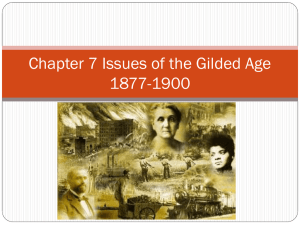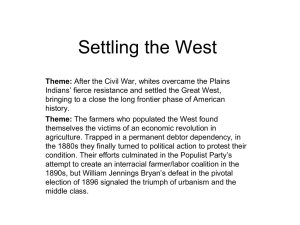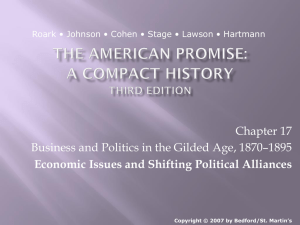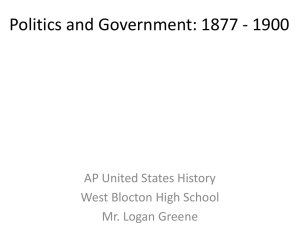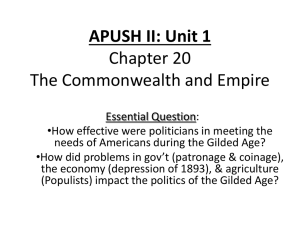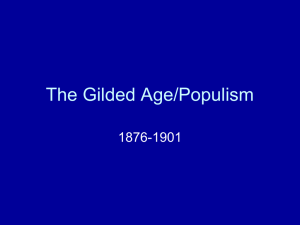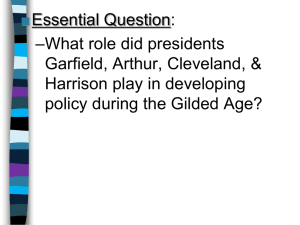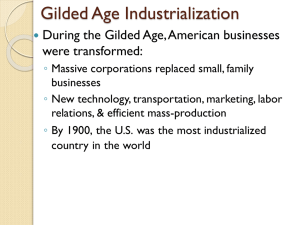Politics of the 1890s
advertisement
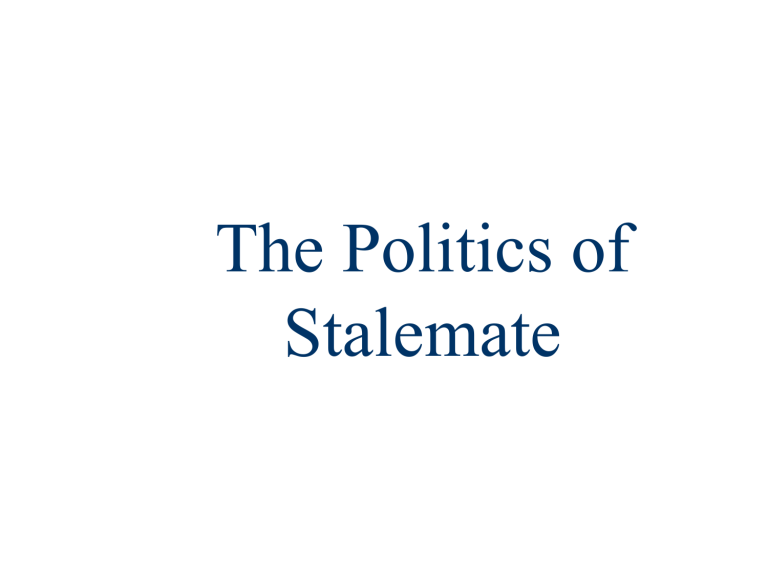
The Politics of Stalemate No more Politics than 1% of popular vote ofthe Stalemate separated the candidates in 4 of 5 elections ■The 5 presidential elections from 1876 to 1892 were the most closely contested elections ever ■Congress was split as well: Pendleton Civil Interstate Commerce –Democrats controlled the House Service Act of 1883 Act of 1887 –Republicans held the Senate Sherman Antitrust McKinley Tariff ■This made difficult Act of“stalemate” 1890 Act of it1890 for any of the 5 presidents or either party to pass significant legislation for 20 years Intense Voter Loyalty to the 2 Parties The Two-Party Stalemate A TwoParty Republicans & Democrats were Stalemate closely divided in New York, Ohio, & Indiana—these 3 states swung the 5 presidential elections As a result, 16 of the 20 presidential & VP candidates were from NY, Ohio, or Indiana Well-Defined Voting Blocs Democratic Bloc Republican Bloc “Waving the Bloody Shirt” continued: Every state that seceded from the United States was a Democratic State…every man that Supported by white Supported by tried to destroy this nation was a Democrat. southerners, farmers, Northern whites, Every man that loved slavery more than liberty immigrants, & the blacks, & nativists was a Democrat. The man that assassinated workingwas poor Lincoln a Democrat…Soldiers, every scar you have got on you heroic bodies wasbig given to Supported Favored white you by a Democrat. business & favored supremacy & —Col Robert Ingersoll to Union veterans anti-immigration supported during labor the 1876 presidential election laws unions Civil Service Reform ■The most important political issue of 1880s was civil service reform: –Republicans were split among Mugwumps (supported reform), “I am a Stalwart, and Arthur is Stalwartspresident (opposed reform), & now!” Half-Breeds (split on reform) –Republican James Garfield was elected in 1880 but was soon killed by Charles Guiteau –If the spoils system could kill a president, it was time to end it State & Civil local governments mirrored these Service Reform civil service reforms in the 1880s & 1890s ■President Arthur & Congress pushed for the Pendleton Act (1883) for competitive exams for civil service jobs ■Republicans chose James Blaine over Arthur as its nominee in 1884 against Grover Cleveland ■Cleveland won & became the 1st Democrat to be elected president in 28 years Pendleton Act A Dirty Campaign Ma, Ma…where’s my pa? He’s going to the White House, ha… ha… ha…! Tariffs & Trusts ■Cleveland sought to reduce gov’t spending & lower the tariff ■Benjamin Harrison narrowly defeated Cleveland in 1888 & The Tariff of Abominations in 1828 Repubs took control of Congress: –Passed the McKinley Tariff of 1890; highest tariff since 1828 –This “Billion-Dollar” Congress expanded gov’t activities “Coming Out” for Harrison Tariffs & Trusts ■From 1870-1900, 28 state commissions were created to Supreme Court ruled: “private property regulate industry, RRs: affecting public interest” especially can be “controlled by publicIllinois for the common good” –Inthe1870, declared RRs to be public highways; this was upheld by Munn v. Illinois (1876) –But was overturned in Wabash v. Illinois (1886): only Congress can regulate interstate trade This was the 1st attempt by the Tariffs & Trusts Thegov’t ICC became the big model federal to regulate business for future regulatory agencies US v. E. C. responded Knight Co (1895) was the ■Congress by creating: 1st test of antitrust law Interstate Commerce The –The Supreme Court ruled that manufacturing monopoly do not restrain trade Commission in 1887 to because regulate making a good is not the same as selling it the railroad industry –The Sherman Antitrust Act in 1890 which made it illegal to restrain trade (punishable by dissolution of the company) The Depression of 1893-1897 ■Voters hated the Republican tariff: –Voted for a Democratic majority in Congress in 1890 & for President Cleveland & Congress Cleveland for president in 1892 responded with the Wilson-Gorman ■In 1893, a collapse in the stock a Tariff Act that reduce tariffs & created slightspiraled income tax not help) into market the(did economy a severer 4-year depression: –500 banks & 1,500 businesses failed; 20% unemployment The Depression of 1893-1897 ■In 1894, there were 1,400 strikes led by hordes of unemployed people demanding gov’t relief: –Jacob Coxey led an “army” from Ohio to D.C. to convince Congress to create jobs by spending $500 million on new roads The Depression of 1893-1897 ■When the Pullman Car Co cut wages & laid off workers, the This was clever application American RRaUnion, led by of the Sherman Antitrust Act Eugene V. Debs, joined the strike: re Debs made the crippled Sherman rail –TheInPullman Strike Act a great anti-labor tool traffic & western farmers –Cleveland issued an injunction & sent US troops; led to violence –In re Debs in 1895, the Supreme Court upheld the injunction since the strike restrained US trade The Farmers’ Movements & the Rise of the Populists The Farm Problem ■By the 1870s, discontent among farmers was growing due to: –Harsh farming conditions –Declining grain & cotton prices –Rising RR rates & mortgages –Government deflation policies ■Farmers lashed out at banks, merchants, railroads, & the US monetary system Price Index for Consumer & Farm Goods (1865-1915) Credit & Money ■Grant’s decision to reduce the # of greenbacks after the Civil War deflated the money supply: –By 1879, the US was restored to the international gold standard & stabilized the US economy –But this policy made money more scarce & limited credit which hurt western farmers This would lead & to inflation & someone Greenback Silver Movements would consistently buy silver from miners ■Many farmers supported the “free In 1878, Congress passed the silver” movement: Bland-Allison Act to coin between –The $2-4 US minted gold million insilver silver&coins coins at a 16:1 ratio, In 1890, Congress passed the but stopped in 1873 Act duetoto an Sherman Silver Purchase increase silver coinage but not to oversupply of gold 16:1 (the act was repealed in 1893) –But western miners found huge lodes of silver & wanted “free silver”—the gov’t should buy all silver from miners & coin it Bi-Metallism Issue The Farmers’ Alliance ■In 1890, the Nat’l Farmers’ Alliance was formed to establish farm cooperatives & provide social gatherings ■In 1890, made Ocala Demands: –Allow farmers to store crops in gov’t silos when prices are bad –Free-coinage of silver, a federal income tax, & no national bank –Direct election of US senators –Tighter regulation of RRs The Populist Party ■In 1890, the Peoples’ Party (Populists) was formed & elected several state & national legislators ■By 1892, the Populists ran James Weaver for president; his platform was the Ocala Demands ■Populists were not happy with the results Even Midwestern Southern Democrats used farmers did not Election racismof & intimidation to The 1892 vote Populist remind whites of the “bloody flag” Upon his election, Cleveland called for and received the repeal of the Sherman Silver Purchase Act which alienated Southern & Western Democrats from the party Black farmers voted Republican & did not support the Populists What does each character represent? Populist Allegory—The Wizard of Oz What about the “Yellowbrick Road” and the “Ruby Slippers”? Good Witch of North? Bad Witch of the East? “Emerald City”? “Oz”? The Wizard? Platform of Lunacy The Election of 1896 “Having behind us the producing masses…we ■A Populist-Democrat merger will answer their demand for the gold standard looked possible in 1896 when ‘You shall not press down upon the brow of William Jennings Bryan received labor this crown of thorns, you shall not crucify mankind uponnomination a cross of gold.’” the Democratic against Repub William McKinley: –Called for free silver & income tax; attacked trusts & injunctions –Bryan visited 26 states on his whistle-stop campaign to education Americans on silver The Election of 1896 ■Advised by RNC chairman, Mark Hanna, McKinley waged a “front porch” campaign from Ohio ■Aided by the press, McKinley’s message reached as many voters: –Advocated economic, urban, & industrial growth –Aroused fear that a “free silver” victory would result in 57¢ dollar Bryan: The Farmers’ Friend 18,000 miles of campaign “whistle stops” The election of 1896 killed the Populist Party, although key platform ideas (income tax, The Election of 1896 secret ballot, direct election of Senators) would be enacted by other parties The McKinley Administration The McKinley Administration ■Republicans benefited from an improving economy, better crop production, & new discoveries of gold: –Election of 1896 cemented Republican rule for 30 years & became party of prosperity –From 1860-1890, Republicans had promoted industry; by 1900, it was time to regulate it The McKinley Administration ■McKinley was an activist president and perhaps was the first “modern” president: –He communicated well with the press –The Spanish-American War brought the USA respect as a world power –The Gold Standard Act (1900) ended the silver controversy Conclusions: A Decade of Dramatic Changes Conclusions: A Decade of Changes ■The economic hardships of the Depression of 1893 forced people to rethink industry, urbanization, & the quality of American life ■Many embraced the need for reform; Led to the beginning of the Progressive Era


